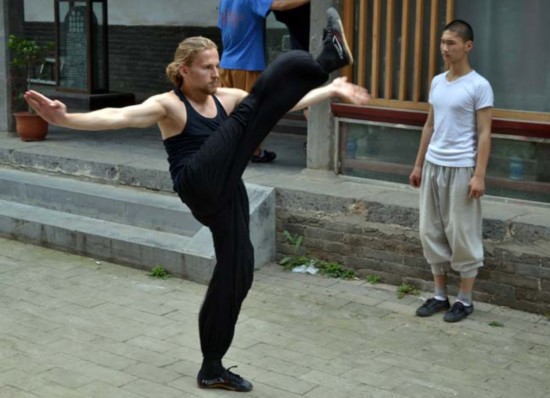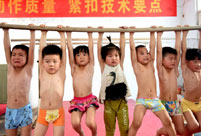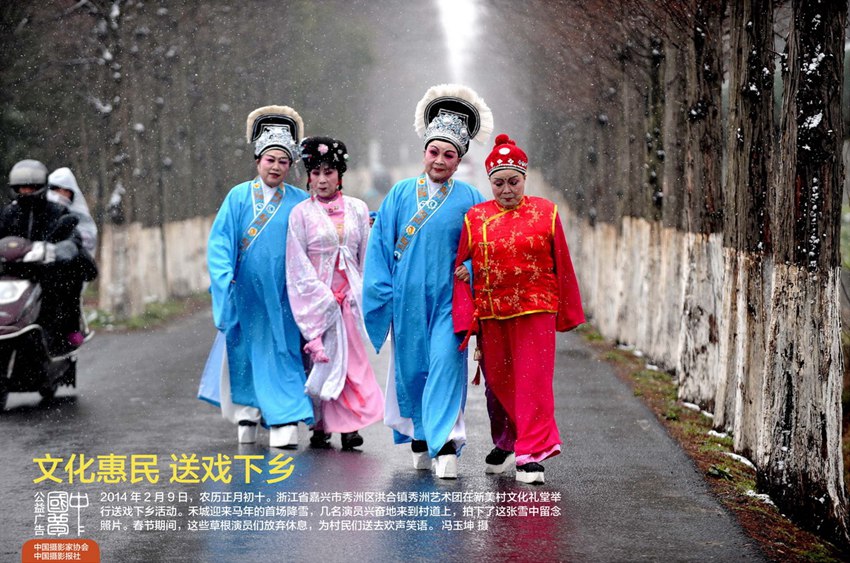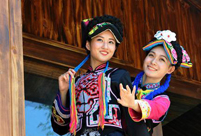 The 4th Chinese National Pole Dance Championship held in Tianjin
The 4th Chinese National Pole Dance Championship held in Tianjin
 Chinese navy commandos debut at 2014 RIMPAC
Chinese navy commandos debut at 2014 RIMPAC
 Guangxi impression: scenic countryside
Guangxi impression: scenic countryside
 World's largest aquatic insect found in Sichuan
World's largest aquatic insect found in Sichuan
 Ceremony volunteers for Youth Olympics make public appearance
Ceremony volunteers for Youth Olympics make public appearance
 A glimpse of female crew of Liaoning aircraft carrier
A glimpse of female crew of Liaoning aircraft carrier
 Stills from "Dad, where are we going?"
Stills from "Dad, where are we going?"
 Legless man's happy life
Legless man's happy life
 Top ten most beautiful islands in China
Top ten most beautiful islands in China
 Aerial view of Hong Kong
Aerial view of Hong Kong

Russian kung fu practitioner Maxim Kojevnikoff warms up in Shaolin Temple on July 3. (PHOTOS BY HOU LIQIANG / CHINA DAILY)
"No matter where you go, there are translators. But for simple daily expression, the monks can manage on their own," said Shi Yongxin.
"Shaolin Temple has emphasized exchanges with different cultures in its 1,500 years and held on to the belief that only communication can result in development," he said.
Liu Yi, deputy dean of the physical culture institute at Hubei University, said people can learn Shaolin kung fu in many training schools, but the temple is the most attractive place for foreigners and visitors because of the culture it represents.
"In Shaolin Temple, kung fu is combined with Chan Buddhism. It includes many aspects of traditional Chinese culture, such as having a strong sense of justice and being ready to help the weak," Liu said.
Many foreigners go to Shaolin not to learn kung fu to fight or defend themselves, but to learn more about these aspects of traditional Chinese culture, Liu said.
Hong Hao, head of the department of physical education at Henan University, said that Shaolin kung fu's combination with Chan Buddhism, which emphasizes meditation, can also make it popular in the West.
Shaolin kung fu can help people in the West who suffer from the fast pace of a competitive society by taking it slow to contemplate life and the value of their existence, he said.
Practicing the martial art can also help foreigners understand Chinese culture better through body language and physical expressions, Hong said.
But the temple needs to continue improving itself, he said. Many people teach its kung fu but there is no uniform standard. That may hinder its popularization, he said.
There are also no specialized teachers of the martial art. The monks are good at kung fu but they might not know how to teach it systematically. The temple also needs to pay more attention to the theoretical study of kung fu, he said.
 |
 Zhujiang ambassadors attend lotus lanterns activity
Zhujiang ambassadors attend lotus lanterns activity
 From girly girl to tough special police officer
From girly girl to tough special police officer
 Children attend gymnastics training in summer
Children attend gymnastics training in summer
 Beautiful sceneries along the special travel route in Xinjiang
Beautiful sceneries along the special travel route in Xinjiang
 Focus on 1st female patrol team in Turpan
Focus on 1st female patrol team in Turpan
 Collection of 'China Dream' public-spirited ads
Collection of 'China Dream' public-spirited ads  National fitness team members integrate traditional and modern beauty
National fitness team members integrate traditional and modern beauty Moms on their kid’s coming out
Moms on their kid’s coming out Chinese fighters through lens
Chinese fighters through lens
 48 hours after super Typhoon Rammasun
48 hours after super Typhoon Rammasun Bikini show held at water park in Xi'an
Bikini show held at water park in Xi'an
 Lobster vs cat: catch me if you can
Lobster vs cat: catch me if you can  Heat waves sweep China
Heat waves sweep China  Top 10 most beautiful islands in China
Top 10 most beautiful islands in China
 Zhou Xun announces engagement to Archie Gao
Zhou Xun announces engagement to Archie Gao
Day|Week|Month